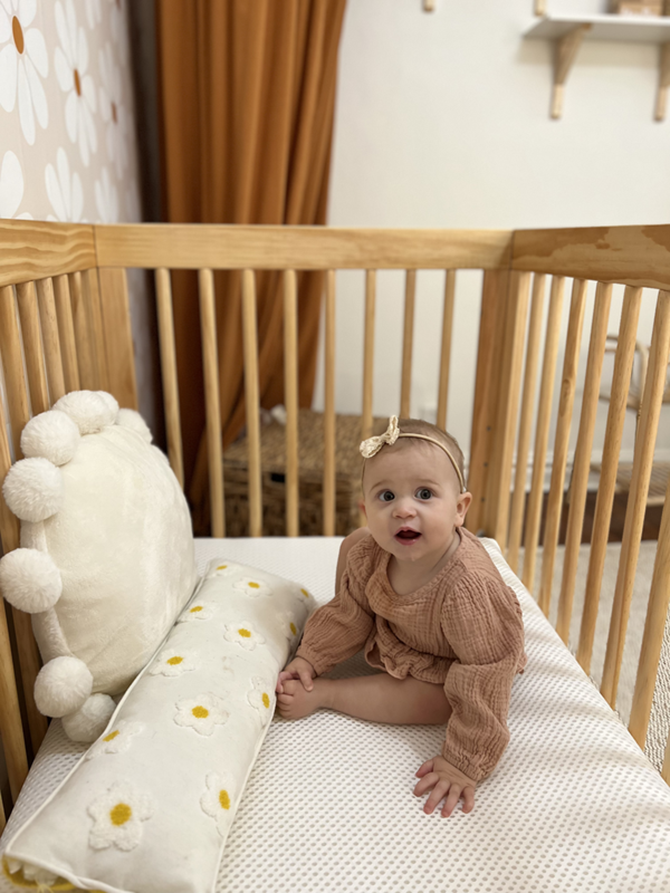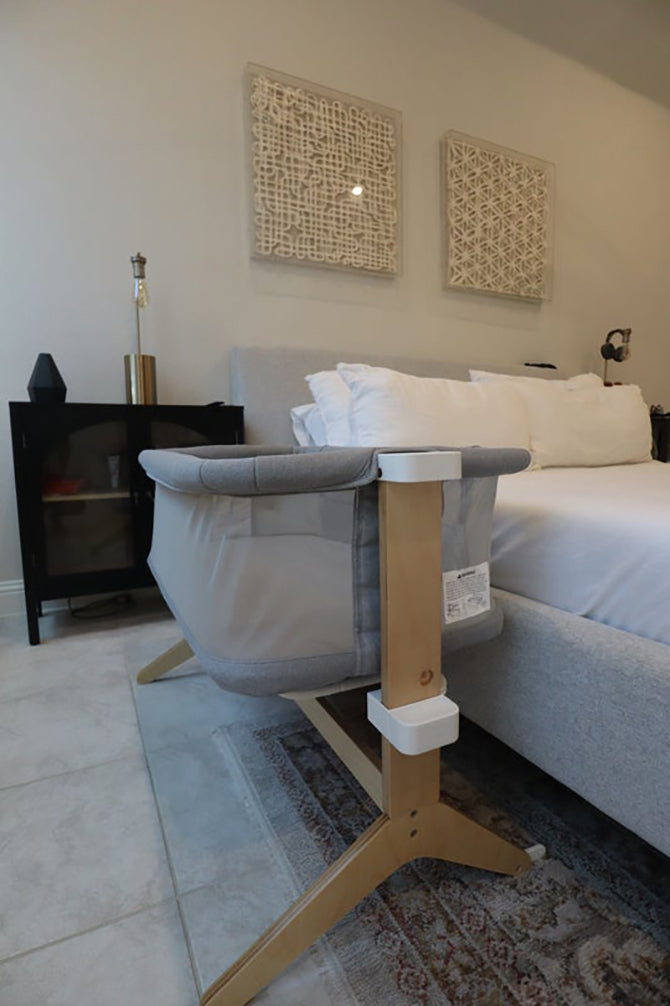
Your little one has been sleeping soundly in their bassinet since you brought them home from the hospital. But now they’re getting bigger, and you know they’ll soon outgrow their little bed. If you’re wondering when to transition your baby to a crib, keep reading.
This guide will help you know when it’s time to make the switch. We’ll discuss the signs to watch for, provide some basic age recommendations, and empower you with tips to make the transition as smooth as possible.
Table of contents
- Newborn bed basics
- When to transition your baby to a crib: Readiness signs
- When to transition your baby to a crib: Age recommendations
- Planning the transition to a crib
- How to transition your baby to a crib
Newborn bed basics

If you choose a crib for your newborn’s first bed, you won’t have to worry about this transition. Your baby will already feel comfortable sleeping in a crib, and they’ll be able to stay there for a long time. However, many parents opt for a bassinet or cradle for the first few months.
These smaller beds can be placed beside a parent’s bed, making nighttime feedings and comfort sessions easier. They also provide a more confined sleeping space for your newborn, which can help them feel more secure.
While bassinets and other newborn beds are helpful, they’re not designed as a long-term sleeping space. They only work for a few months. Once your baby outgrows them, you’ll need to transition them to a larger bed, like a crib.
When to transition your baby to a crib: Readiness signs
There’s no set age for transitioning your baby to a crib. Every baby is different, and they reach developmental milestones at their own pace.
So, how do you know when it’s time to make the switch? Here are three readiness signs to watch for.
Pushing up on their hands and knees
Bassinets are designed for newborns who don’t move around much. They aren’t meant to contain active babies.
If your little one starts pushing up on their hands and knees, it’s time to move them. A crib will give them more space to move around without hitting their head or face on the sides.
Approaching the weight limit
All bassinets and cradles have weight limits. For example, the Newton Bassinet & Bedside Sleeper has a 20-pound limit. However, many other beds have lower limits. You’ll need to check your owner’s manual to see how much weight your baby’s bed can safely handle.
Depending on how big your baby was at birth, they could reach this limit sooner than you think. It’s not uncommon for a large three-month-old to outgrow their newborn bed.
Of course, the opposite is also true. If your baby was born prematurely or with a low birth weight, they could stay in their newborn bed longer.
Sitting up

Newborn beds don’t come with tall sides. Once your baby can sit up, they can easily topple over the edge. There’s just not much there to keep them inside.
To avoid the risk of falls, transition your baby to a crib once they show signs of sitting up, such as:
- Leaning forward and balancing on their arms when you put them into a sitting position
- Sitting with support for a few moments
- Rolling over both directions
These skills indicate that your baby is ready for a different bed.
When to transition your baby to a crib: Age recommendations
Typically, babies with the skills listed above will be in the 3-6 month age range. But your little one may be ready slightly before or after this window.
The most important thing is to watch the developmental milestones above and make the transition when you feel it’s safe for your baby.
However, if your baby is approaching six months and you want to keep using the newborn bed, it’s best to speak with their doctor to make sure it’s still a safe sleep spot.
Planning the transition to a crib
Now that you know when to transition your baby to a crib, let’s discuss how. Thinking through the process in advance means you won’t be left scrambling when the big day comes.
Review safety standards.
The good news is that safe sleep guidelines remain the same from the newborn bed to the crib, so you don’t have to worry about making major changes in this area.
However, it’s always a good idea to double-check and make sure your crib meets the current safety standards before use.
And, of course, you’ll want your baby to sleep:
- On their back
- On a flat surface
- Without any pillows or blankets
- With a snug-fitting, firm mattress
The Newton Baby Crib Mattress can give you peace of mind. It’s 100% breathable, as you can see in this video:
Create a proper sleep environment.
Moving the baby into the crib often means putting them into their own room. And while that is an option, don’t feel like you have to move them out of your room yet. If you have space for a crib, it’s perfectly acceptable to keep room sharing for several more months.
Either way, ensuring your baby has a proper sleep environment can help you both get more shut-eye. Keep the room cool, dark, and quiet. Consider using a white noise machine to block outside noise and help your baby sleep better.
Now is also the time to start babyproofing the room if you haven’t yet. Make sure there aren’t any cords or wires within reach. And if you hang a mobile above the crib, make sure it’s high enough that your baby can’t grab it.
Get the crib ready.
Cribs aren’t always easy to assemble, especially when you’re working alone. Grab a friend or partner and work together to set the bed up if possible.
Do this a few days in advance if you can. That way, your baby can get used to the new bed before they have to start sleeping in it.
When assembling the crib, make sure all the screws and bolts are tight. Put the mattress at the proper height for your baby’s age, and double-check that there aren’t any gaps around the edges. Then lock the bed’s wheels or casters if it has them.
Next, put on a Waterproof Crib Mattress Pad and a sheet. The crib is ready for your baby!
How to transition your baby to a crib

Once you’ve assembled the crib, pick a day to begin the transition process. Then, follow these tips to help your baby learn to sleep in a new space:
- Start early: Change is hard for some kids. If you think your little one will balk at sleeping in a new place, start the transition sooner rather than later. Then, you won’t feel as pressed for time and you’ll be able to go at a pace that works for your baby.
- Establish a bedtime routine: Consistency is key when establishing healthy sleep habits. Create a calming bedtime routine that’s simple enough to do every night, such as a bath, a book, and a lullaby.
- Go slowly: Start with naps and help your baby get used to the crib during the day. Once they’re comfortable napping in their new space, you can put them in the crib for bedtime.
- Prepare for sleep regression: Unfortunately, big changes often lead to sleep regression. Be prepared for disrupted sleep patterns for a few days. Offer extra comfort and reassurance during this time, and know it won’t last forever.
- Be patient: Babies need a little time to adjust to new environments. Be patient and understanding as they learn to sleep in a crib. Soon, they’ll feel comfortable in this space and it won’t be as scary.
Pay attention to your baby and see how they’re doing throughout the process. If they seem uncomfortable and upset, it’s OK to take a step back and try again in a few days.
You may also want to consider other options. For example, you could use a play yard or mini-crib instead of moving your baby straight to a crib.
These beds are an excellent transitional step since they’re larger than a bassinet or cradle but smaller than a full-size crib. This can help your baby feel more secure and comfortable while adjusting to the new sleeping arrangements.
From bassinet to crib, Newton is here for you.

Knowing when to transition your baby to a crib can be daunting for new parents. But by keeping an eye out for readiness signs and using their age as a guideline, you’ll know when the time is right.
And no matter what bed your little one is in, Newton Baby is here to provide a safe and comfortable sleep environment. With our breathable and washable crib mattress and other nursery essentials, you can feel confident that your little one is getting the best sleep possible.
So don’t stress about the transition from bassinet to crib — you’ve got this. Happy sleeping!
